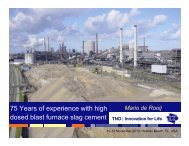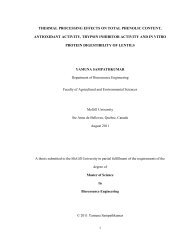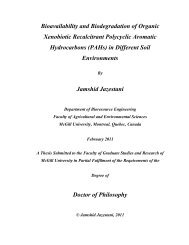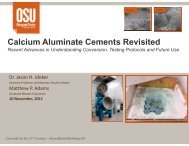foam-mat freeze drying of egg white and ... - McGill University
foam-mat freeze drying of egg white and ... - McGill University
foam-mat freeze drying of egg white and ... - McGill University
Create successful ePaper yourself
Turn your PDF publications into a flip-book with our unique Google optimized e-Paper software.
To achieve <strong>drying</strong> we need to supply latent heat <strong>of</strong> subli<strong>mat</strong>ion (for ice at 0 °C<br />
this is 2840 kJ/kg (Flink & Knudsen 1983; Liapis & Bruttini 1995)). During subli<strong>mat</strong>ion,<br />
latent heat is absorbed which results in the temperature reduction in the frozen layer. If<br />
there is no heat input, the water vapour pressure <strong>of</strong> the frozen product comes into<br />
equilibrium with the <strong>drying</strong> chamber <strong>and</strong> there will be no further subli<strong>mat</strong>ion. The latent<br />
heat supply can be achieved either by conduction, convection or radiation. During <strong>freeze</strong>-<br />
<strong>drying</strong>, conduction <strong>and</strong> radiation heat transfers are more common than convection. The<br />
amount <strong>of</strong> heat that could be supplied without affecting the product is one <strong>of</strong> the limiting<br />
factors in <strong>freeze</strong> <strong>drying</strong>. One <strong>of</strong> the important limiting factors for heat input is the<br />
maximum temperature the frozen layer could withst<strong>and</strong> <strong>and</strong> remain frozen. Melting <strong>of</strong><br />
frozen layer can have adverse effect on the product quality in many ways. Collapse can<br />
occur, which results in structural defor<strong>mat</strong>ion <strong>of</strong> the dried product. Some other factors<br />
which affect the maximum heat input are colour sensitivity <strong>of</strong> the product, biosensitivity<br />
<strong>of</strong> the product <strong>and</strong> structural defor<strong>mat</strong>ion in the dried product (Mellor 1978; Flink &<br />
Knudsen 1983; Liapis & Bruttini 1995).<br />
Usually the subli<strong>mat</strong>ion <strong>of</strong> water starts at the surface <strong>and</strong> water vapour is directly<br />
removed. After some time <strong>of</strong> <strong>drying</strong>, the product will have two distinct layers: the ‘Dry<br />
layer’ <strong>and</strong> the ‘Frozen layer’. Once a dry layer is formed, the water vapour is transferred<br />
through it. In ideal <strong>drying</strong> conditions both layers can be distinguished properly (Figure<br />
3.6 (a)). But in practical <strong>drying</strong> conditions that may not be the case, usually there will be<br />
a transition layer between frozen <strong>and</strong> dry layer (Figure 3.6 (b)). The end <strong>of</strong> the primary<br />
<strong>drying</strong> stage is marked by a sharp decrease in <strong>drying</strong> rate. By the end <strong>of</strong> the primary<br />
25









